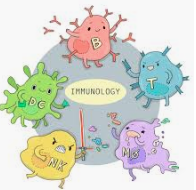DISEASE ASSOCIATED with IMMUNE SYSTEM Multiple Choice Questions :-
1. The HIV virus infects primarily
A. brain cells
B. cells in the immune system
C. red blood cells
D. liver cells
Answer: B
2. Chronic granulomatous disease results from a failure to perform oxidative burst. This deficiency would be most likely to interfere with
A. CTL killing of viruses
B. dendritic cell activation to become a mature APC
C. infected cell processing of virus peptides
D. macrophage intracellular killing of bacteria
Answer: D
3. Difficulties with somatic gene therapy arise from all of the following except
A. GVHD caused by mature T cells in the transplanted cells
B. inserting a gene so that it will function properly
C. limited life span of more mature hematopoietic cells
D. transducing genetic material into stem cells
Answer: A
4. A monoclonal antibody (mAb) specific for the 2,4-dinitrophenyl (DNP) hapten might also bind
A. Leu or Ileu
B. His or Pro
C. Tyr or Phe
D. Ser or Thr
Answer: C
5. Retinoblastoma is due to a mutation in a
A. kinase
B. tumor supressor
C. cyclin
D. viral gene
Answer: B
6. An autoimmune disease is
A. AIDS
B. Measles
C. Lupus
D. Mumps
Answer: C
7. If Class IIMHC is not expressed in the thymus, the resulting immune deficiencies would include all of the following except reduced
A. alternative complement activation.
B. CD8 T cell-mediated cytotoxicity
C. macrophage activation to vesicular pathogens
D. IgG synthesis
Answer: A
8. Specific translocations are associated with
A. colon cancer
B. breast cancer
C. pancreatic cancer
D. some leukemias
Answer: D
10. The primary reason for AIDS, a deadly disease is that it
A. is caused by a virus
B. is caused by a bacterium
C. destroys key components of the body’s internal defense system
D. causes a breakdown of the body’s inflammatory response
Answer: C

DISEASE ASSOCIATED with IMMUNE SYSTEM Objective type Questions with Answers
11. A selective IgA deficiency would be expected to result in problems with
A. bacterial infections
B. infections following dental work due to bacteria entering the bloodstream
C. mucosal pathogens
D. pathogens which can survive inside macrophages
Answer: C
12. Combined cellular and humoral immune deficiencies result from lack of all of the following except
A. a thymus
B. class II MHC
C. HIV infection of CD4+ T cells
D. transporter of antigen peptides (TAP)
Answer: D
13. An example of an immunodeficiency disorder is
A. thyroiditis
B. rheumatic fever
C. systemic lupus erythematosus
D. AIDS
Answer: D
14. Bone marrow given to an infant with SCID must
A. be irradiated to eliminate GVHD
B. contain mature T cells that can begin making immune responses immediately
C. come from a donor that shares some MHC alleles with the recipient
D. come from one of the child’s parents
Answer: C
15. X-linked hyper IgM syndrome, resulting in high levels of serum IgM and low levels of serum IgG, is caused by a defect in CD40L expression. The specific immune event that would be prevented by a defective CD40L would be
A. activation of B cells by T-independent antigens
B. failure of B cells to provide co-stimulation for Th2 activation
C. failure of Th2 cells to provide co-stimulation for B cell isotype switching
D. failure of Th2 cells to provide co-stimulation for B cell proliferation
Answer: C
16. DiGeorge’s syndrome is characterized by the lack of a thymus The mouse model closest to this human disease would be a
A. knock-out mouse for RAG-1 and RAG-2
B. knock-out mouse for a thymus
C. nude mouse
D. recombinant mouse for CD3
Answer: C
17. Which of the Rous sarcoma virus has a homologous cellular protein?
A. c-src
B. v-src
C. v-ha-src
D. v-ha-ras
Answer: A
18. Infants are most susceptible to bacterial infection due to low circulating levels of IgG
A. in utero (before birth)
B. at 0-3 months of age
C. at 3-12 months of age
D. at 12-24 months of age
Answer: C
19. The chemical, typically released by the body in an allergic response is
A. histamine
B. allergens
C. antihistamines
D. perforins
Answer: A